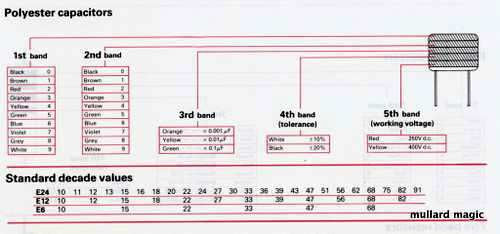
CAN YOU TELL ME ABOUT MULLARD TROPICAL FISH CAPACITORS?
Share
Again, I shall pause from my historical Mullard meanderings to answer a query I have received from a customer from Malaysia about the Mullard ‘Tropical Fish’ capacitors, so called due to their colourful body stripes which denote value – more on this later!
These capacitors, introduced to the radio market in 1964 have a polyester dielectric which exhibits very low dielectric loss, high insulation resistance coupled with good temperature and moisture resistance, however, for physical integrity they are not perhaps as tough as the Mullard ‘Mustard’ capacitors. All told though, they far exceed the efficiency of paper dielectric capacitors and impart a very similar sonic signature in audio applications, indeed many classic guitar amp designs utilize them in construction I am told.
Although they are colloquially referred to as ‘Tropical Fish’ capacitors, their true moniker is the C280 Miniature Metallised Polyester Film Capacitor and they came in two voltage ratings, 250V and 400V wkg. I have been asked how to read the colour codes and here is a handy diagram to help with that task:-

In literature and original Mullard packaging, the C280 series is described by codes and I am often asked how to interpret these, well, the prefix C stands for capacitor, 280 is the series type of the capacitor, the prefix commences with AE for 250V rating and CF for 400V rating. The coding will then continue in the form C280yy/xxx. where the first (post slash) letter that indicates the tolerance of the capacitor. In the case of the 280 series, A = +/- 10% and P = +/- 20%. The continuation of the code is based on the capacitance value of the device where a numerical figure is followed by the letter K or M. In summary, one can always easily read the capacity of the device by considering the letter K to equate to the unit nF and the letter M to equate to the unit uF with the numerical component to be the value. To translate the nF or uF value into other units of capacitance, the following conversion factor may be applied.
1uF = 1000nF = 1000000pF
Anyhow, because I am a top geeza, I have produced a table showing the ENTIRE range of C280 capacitors ever made with their corresponding codes and capacitance values in various Farad units - pretty good huh?
|
TYPE NUMBER |
CAPACITANCE (uF) |
CAPACITANCE (nF) |
CAPACITANCE (pF) |
WKG VOLTAGE (V) |
|
|
|
|
|
|
|
C280AE/A330K |
0.33 |
330 |
330000 |
250 |
|
C280AE/A470K |
0.47 |
470 |
470000 |
250 |
|
C280AE/A680K |
0.68 |
680 |
680000 |
250 |
|
C280AE/A1M |
1.0 |
1000 |
1000000 |
250 |
|
C280AE/A1M5 |
1.5 |
1500 |
1500000 |
250 |
|
C280AE/A2M2 |
2.2 |
2200 |
2200000 |
250 |
|
C280AE/P10K |
0.01 |
10 |
10000 |
250 |
|
C280AE/P15K |
0.015 |
15 |
15000 |
250 |
|
C280AE/P22K |
0.022 |
22 |
22000 |
250 |
|
C280AE/P33K |
0.033 |
33 |
33000 |
250 |
|
C280AE/P47K |
0.047 |
47 |
47000 |
250 |
|
C280AE/P68K |
0.068 |
68 |
68000 |
250 |
|
C280AE/P100K |
0.1 |
100 |
100000 |
250 |
|
C280CF/A330K |
0.33 |
330 |
330000 |
400 |
|
C280CF/A470K |
0.47 |
470 |
470000 |
400 |
|
C280CF/A680K |
0.68 |
680 |
680000 |
400 |
|
C280CF/A1M |
1.0 |
1000 |
1000000 |
400 |
|
C280CF/P10K |
0.01 |
10 |
10000 |
400 |
|
C280CF/P15K |
0.015 |
15 |
15000 |
400 |
|
C280CF/P22K |
0.022 |
22 |
22000 |
400 |
|
C280CF/P33K |
0.033 |
33 |
33000 |
400 |
|
C280CF/P47K |
0.047 |
47 |
47000 |
400 |
|
C280CF/P68K |
0.068 |
68 |
68000 |
400 |
|
C280CF/P100K |
0.1 |
100 |
100000 |
400 |
|
C280CF/P150K |
0.15 |
150 |
150000 |
400 |
|
C280CF/P220K |
0.22 |
220 |
220000 |
400 |
